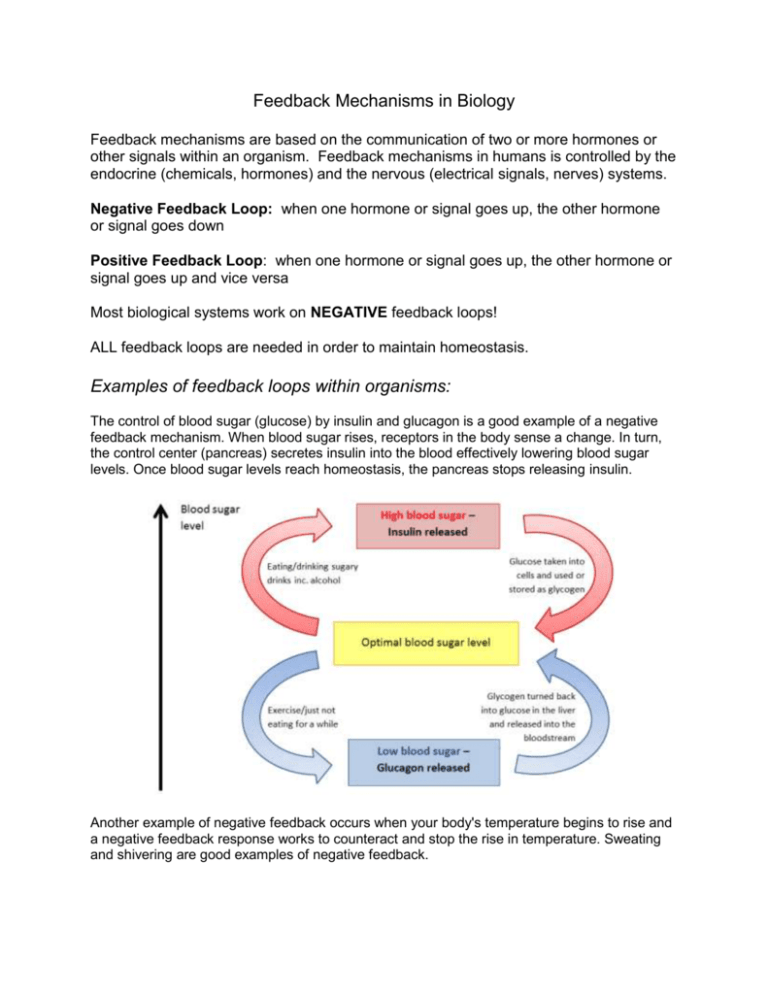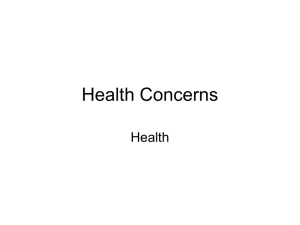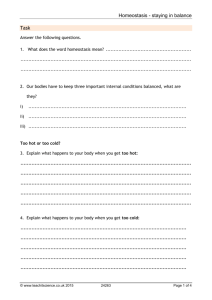Feedback Mechanisms Note Set
advertisement

Feedback Mechanisms in Biology Feedback mechanisms are based on the communication of two or more hormones or other signals within an organism. Feedback mechanisms in humans is controlled by the endocrine (chemicals, hormones) and the nervous (electrical signals, nerves) systems. Negative Feedback Loop: when one hormone or signal goes up, the other hormone or signal goes down Positive Feedback Loop: when one hormone or signal goes up, the other hormone or signal goes up and vice versa Most biological systems work on NEGATIVE feedback loops! ALL feedback loops are needed in order to maintain homeostasis. Examples of feedback loops within organisms: The control of blood sugar (glucose) by insulin and glucagon is a good example of a negative feedback mechanism. When blood sugar rises, receptors in the body sense a change. In turn, the control center (pancreas) secretes insulin into the blood effectively lowering blood sugar levels. Once blood sugar levels reach homeostasis, the pancreas stops releasing insulin. Another example of negative feedback occurs when your body's temperature begins to rise and a negative feedback response works to counteract and stop the rise in temperature. Sweating and shivering are good examples of negative feedback. An example of positive feedback also can happen in your stomach. Your stomach normally secretes a compound called pepsinogen that is an inactive enzyme. As your body converts pepsinogen to the enzyme pepsin, it triggers a process that helps convert other pepsinogen molecules to pepsin. This cascade effect occurs and soon your stomach has enough pepsin molecules to digest proteins. A good example of a positive feedback system is child birth. During labor, a hormone called oxytocin is released that intensifies and speeds up contractions. The increase in contractions causes more oxytocin to be released and the cycle goes on until the baby is born. The birth ends the release of oxytocin and ends the positive feedback mechanism. Another good example of a positive feedback mechanism is blood clotting. Once a vessel is damaged, platelets start to cling to the injured site and release chemicals that attract more platelets. The platelets continue to pile up and release chemicals until a clot is formed. Plants have feedback mechanisms that have evolved as well. The opening and closing of the stomata by the guard cells (stomatal rhythm)- In light, guard cells take up water by osmosis and become turgid. Because their inner walls are rigid they are pulled apart, opening the pore. In darkness water is lost and the inner walls move together closing the pore.Because of this, the transpiration rate is increased by an increase in light intensity. Plants which live in extreme environments have adaptations to control their transpiration rate.











